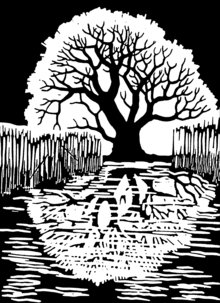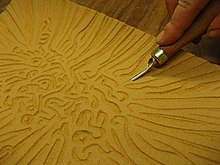Linocut
The linocut is a graphic technique that works in relief printing and is basically similar to the woodcut . As in the woodcut, a negative pattern is cut into the normally relatively solid linoleum in a linoleum sheet with a special tool. The material can be cut easily and in any direction. The finished negative pattern is rolled over with paint and then printed on paper. The ink adhering to the raised areas is transferred to the paper. Like the woodcut, it was also valued by expressionist artists. Maurice de Vlaminck , Christian Rohlfs , Henri Matisse , MC Escher and Pablo Picasso worked with linocut.
Features of the linocut
The linocut shows clear surfaces and smooth outlines. The structure of the colored surfaces caused by the grain of the material, as can be seen in the woodcut, is missing. Both white line cutting , surface interface as well as black-line interface are possible. When colored thinly, it shows speckled structures due to the occasionally porous material. In color linocut, the print often has thick, leathery, stiff-looking and sometimes gritty structures: Such sheets must not be rolled, as the colored areas on the paper can break. Before modern typesetting techniques made it possible to machine large lettering, typesetters occasionally used it to create advertising prints and posters.
Recommended tools and materials
For the linocut you need a screw holder with various cutting blades, a contour knife , a goat foot , a flat lifter, a gouge, a printing press , linoleum, paint, a paint roller and paper. But it is also possible to improvise with kitchen utensils such as a wooden spoon. This is used to rub off the ink by hand and replaces a - sometimes very expensive - printing press.
Cutting technique
The tools used are carving knives, gouges and goat's feet (U- and V-shaped blades) in various strengths. The linoleum is easier to cut if it is heated a little. Leftovers from PVC floor coverings can be cut even more easily and finely. The edges of the remaining area must not be undercut. Otherwise they would give in or even break out when printing.
Printing technology
Oil-based inks are common as printing inks, but water-soluble inks (Japanaqua) are also available in specialist shops. With a rubber roller, the paint is first distributed on a smooth surface (such as a glass plate) and absorbed evenly. The plate is then colored, making sure that it is distributed evenly. It is printed on paper that accepts the color well, but printing on fabric and other absorbent surfaces is also possible.
Color linocut
Colored linocuts can be created by overprinting two or more colors. With transparent colors, intermediate colors can also be produced by mixing them overprinted ( subtractive color mixing ). Various methods have been developed over time.
- Partial coloring of a single plate with several colors
- Precisely fitting printing with multiple, differently colored plates
- Elimination pressure
Elimination pressure
It is printed with several colors and only with one plate. After printing one color, the plate is processed further and printed with the next color, so that more and more of the printing plate is removed. We therefore also speak of printing with a lost plate or reduction printing. The previous colors remain visible where the printing surface was removed.
Among others, Pablo Picasso was recommended this technique by his long-time printer Hidalgo Arnéra. Since Picasso often worked on several pictures at the same time, he often had difficulties cutting the different printing plates for a multicolored graphic. This problem was eliminated with the elimination technique.
Milk carton print
The milk carton print is a particularly simple variant, suitable for children. For this purpose, a square Tetra Pak milk bag is cut open on the inside, the motif is recorded or traced from a template. The motif is drawn with a ballpoint pen or a wooden stick with a round tip so that grooves are formed in the cardboard. The lino printing ink is spread on a glass plate with a hard rubber roller, as is the case with linoprint, and thinly taken up on the roller and spread just as thinly on the milk carton. A paper pressed onto the colored milk carton with a clean second hard rubber roller results in a high pressure . If you fill the grooves with paint with a plastic spatula or an old credit card and then clean the surfaces with some kitchen paper, you get a gravure printing process . Instead of the manual hard rubber roller, you can also use a pasta machine for another purpose and cover the paper and the milk carton on both sides with kitchen paper and place a thin piece of felt on both sides and turn the whole package through the pasta machine.
literature
- Astrid Clasen: The linocut. From the idea to the finished print. Augustus-Verlag, Augsburg 1989, ISBN 3-8043-2728-1 .
- Walter Koschatzky : The art of graphics. Technology, history, masterpieces (= dtv 1120). 3rd edition, 33rd – 42nd edition Thousand. Deutsche Taschenbuch-Verl, Munich 1977, ISBN 3-423-01120-3 .
- Lothar Lang: The graphics collector. A book for collectors and everyone who wants to become one. Henschelverlag Art and Society, Berlin 1979.
- Christina Cohen-Cossen: woodcut and linocut. History, techniques and projects. Haupt, Bern et al. 2009, ISBN 978-3-258-07497-9 .
Web links
Individual evidence
- ↑ Milk carton printing with pasta machine (Video 4'36 ", English)




